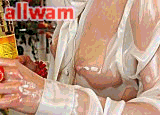Wetlook World ForumCurrent time: Fri 19/04/24 11:21:15 GMT | 
|
Wetlook World ForumCurrent time: Fri 19/04/24 11:21:15 GMT | 
|
|
Message # 60850.4.2 Subject: Date: Tue 18/03/14 01:59:23 GMT Name: EdR Email: asplashofglamour@gmail.com Website: www.asplashofglamour.com |
Report Abuse or Problem to Nigel at Minxmovies
|

|
|
justauser
-"File sizes are an issue, right. But flash cards get cheaper and cheaper and on an affordable one I get enough photos to empty out two batteries (>500pics). If you spend two grand on a pretty good camera body and the same on lenses and equipment, why should fast flash cards be an issue?"
The problem isn't so much the flash cards or how many RAW vs JPEG images you can save on them as you take the photos. Flash card manufacturers have been able to produce larger and larger capacity cards even out pacing the needs of ever larger megapixels and video capability. The problem of file size hits you down the line, at your computer. Productive photographers can take tens of thousands of photographs over the course of a year. Saving RAWs can take considerable hard drive space especially when you consider that many professional photographers make copies of their work to prevent losing images.
"One thing about burned-out areas: Digital cameras are very good at dark areas, so when shooting, dial down to -.3 or -.7EV. Doesnīt hurt dark spots too much, but saves you from overexposed spots."
A subject of debate among photographers, there is the argument that it's better to brighten an underexposed image than it is to turn down an overexposed image. There is no doubt that you cannot restore lost details in a "clipped" image. "Clipping" is a term used by photographers to describe information or details that are lost in either the highlights or lowlights. Wether it's way too overexposed or way too underexposed, if there is no captured details, you cannot alter the exposure and return lost details to the image. The argument for turning up an underexposed image is supported by those who believe that the camera can capture more details in the lowlights, however there is no evidence that cameras capture more details in the lowlights as opposed to the highlights. The distinct disadvantage of turning up an underexposed image is that it can result in unwanted noise within the darkest portions of the image. Turning down an overexposed image will not result in noise, but lost details in the highlights tend to appear more noticeable. The advantage of using RAW is that advanced photoshop programs can allow for tremendous control over the dynamic range of the image allowing either highlights or lowlights to be adjusted independently of each other, and with some work it's possible to "paint in" clipped details.
EdR |
| In reply to Message (60850.4) By justauser -
Iīm no producer, I donīt even do any wetlook shots. But I do some hobby photographing.
Even for me RAW is the choice, as it is pretty much lossless and does not interpret anything. In a photoforum I once compared the jpeg from the camera with the "developed" jpeg from some different post-processing tools (one from the camera manufacturer), all set to non-altering parameters. There were quite noticeable differences. Jpeg has another problem, it is not lossless, which may lead to effects around edges.
File sizes are an issue, right. But flash cards get cheaper and cheaper and on an affordable one I get enough photos to empty out two batteries (>500pics). If you spend two grand on a pretty good camera body and the same on lenses and equipment, why should fast flash cards be an issue?
One thing about burned-out areas: Digital cameras are very good at dark areas, so when shooting, dial down to -.3 or -.7EV. Doesnīt hurt dark spots too much, but saves you from overexposed spots. |
| In reply to Message (60850) By GeorgeSK -
A question to producers: Do you do post processing to your pictures or upload as they come out of the camera?
I am just asking because I like to use wetlook pics from my favourite producer (Wetfoto) as a desktop background and I noticed lately that many of the pics, especially the ones taken in bright sunlight, seem to be a bit "washed out" and overexposed.
When I do my image processing magic, they look like a totally different picture without them looking unnatural - adjusting levels and curves to get more contrast and as a finishing touch, I have a new weapon in my arsenal - Topaz Adjust 5, which gives them the required punch - nicer colours and more detail.
This was not meant as a criticism, just a question. I realise that it would be time consuming, but the basic levels and curves could be automated by finding a generic "good value" and use a Photoshop action to batch convert the images.
Thanks in advance for your reply.
|
Report Abuse or Problem to Nigel at Minxmovies
If you enjoy this forum, then please make a small donation to help with running costs:
![]() (you can change amount)
(you can change amount)


|


|
[ This page took 0.026 seconds to generate ]